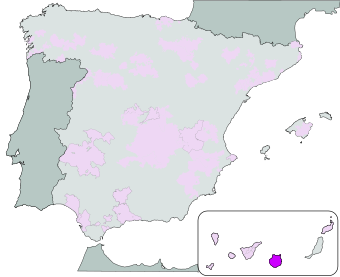Gran Canaria (DO) facts for kids
| Wine region | |

Gran Canaria DOP in the province of Las Palmas in the region of the Canary Islands
|
|
| Official name | D.O.P. Gran Canaria |
|---|---|
| Type | Denominación de Origen Protegida (DOP) |
| Year established | 2009 |
| Country | Spain |
| No. of vineyards | 231 hectares (571 acres) |
| Wine produced | 2,205 hectolitres |
| Comments | Data for 2016 / 2017 |
Gran Canaria is a special kind of wine from the island of Gran Canaria in Spain. It's called a "Protected Designation of Origin" (DOP). This means the wine must come from this island and follow strict rules to ensure its quality. The Gran Canaria DOP officially started in 2009. It covers the entire island, which has 21 different towns.
The Story of Gran Canaria Wine
Growing grapes on Gran Canaria started a long time ago. The first grapevines arrived from Crete around the end of the 1400s.
By the 1500s, wines from the Canary Islands became very popular. They were known for being good quality. People started exporting them to places like England, Flanders, Hamburg, and even the New World.
Around the middle of the 1500s, wine became super important for Gran Canaria's farms. It was the main product they sold to other countries. This happened because sugar cane farming was becoming less popular.
However, this good time for wine didn't last. A big war, the War of the Spanish Succession, changed things. The English started buying wine from Portugal instead. This made it very hard for Gran Canaria's wine business. For a long time, wine production and trade almost stopped.
Grape Varieties Allowed
To make wine under the Gran Canaria DOP, winemakers must use specific types of grapes. These are called "authorised grape varieties." Some are "preferred," meaning they are the best ones to use.
Red Grapes
The preferred red grapes are:
- Bastardo Negro
- Listán Negro
- Negramoll
- Tintilla
- Malvasía Rosada
Another red grape that is allowed is:
- Moscatel Negro
White Grapes
The preferred white grapes are:
- Malvasía Volcánica
- Gual
- Bermejuela
- Vijariego
- Albillo
- Moscatel de Alejandría
Other white grapes that are allowed are:
- Listán Blanco
- Burrablanca
- Torrontés
- Breval Blanca
- Pedro Ximénez
See also
 In Spanish: Gran Canaria (vino) para niños
In Spanish: Gran Canaria (vino) para niños

